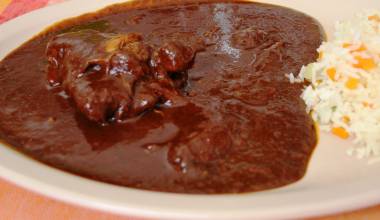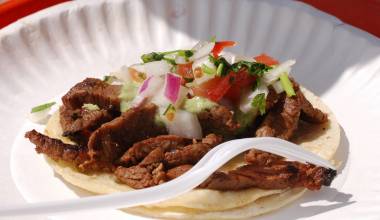15 Staples of the Central American Kitchen

Image by Karen Corby
Mexican food has long been one of the most popular cuisines in the United States. But lately, Americans' never-ending search for new and exciting dishes has led them to venture further afield to sample the cooking of Mexico's neighbors on the Central American isthmus.
With the arrival over the last couple decades of immigrants from these nations, many more Americans have been exposed to the variety of foods enjoyed by their friends to the south. At the same time, many of the ingredients needed to make signature dishes of the immigrant cuisines are now more widely available in the United States than ever. Here are fifteen basic ingredients any aficionado of Central American cuisine should really have in their pantry.
1. Corn
Corn in its many forms is the staple food of Central American cuisine. While fresh corn (elote) is enjoyed grilled on the cob, steamed in tamales de elote and as coblets simmered in steaming caldos, corn is most commonly turned into masa, a corn dough that is the foundation for tortillas, tamales, pupusas and sopes.
Masa is made from corn that has undergone nixtamalization, a process that renders it more nutritious and digestible. The result — called nixtamal in Spanish and hominy in English — is ground into a soft dough and sold at local markets. Fresh masa is best; if you can find it, buy it. But masa harina, a dried masa flour, is a fine substitute for those who are unable to buy it fresh. Just mix it with warm water.
Masa is also used in traditional beverages called atoles. Toasted cornmeal thickens the Nicaraguan cocoa-flavored beverage called pinolillo. And corn mash is fermented into a home brew called chicha.
2. Rice
After corn, the second most common grain-based food in Central America is rice. Rice was introduced to the New World by the Spanish and by African slaves. In Mesoamerica, rice is usually cooked simply with perhaps a few peas or chopped carrots thrown in for color. For more festive occasions, rice will be vibrantly colored with finely chopped herbs like cilantro, with tomato sauce or given the golden tint of saffron. The fundamental meal for the Central American peasantry has always been and continues to be rice and beans. Which brings us to...
3. Beans
Central America is home to a bewildering variety of dried beans. While there are no hard and fast rules, each region tends to favor a particular type. In northern Mexico, pinto beans rule the roost. Cooks in southern Mexico, Guatemala and Belize prefer black beans. In Nicaragua and Honduras, the bean of choice is red. Farther south in Costa Rica, El Salvador and Panama, black beans again resume their popularity.
Beans are often eaten at every meal. Stewed, refried or stirred into rice, they are a great source of protein and fiber in a diet that is sometimes meager. The pairing of beans and rice even takes on cultural significance given its importance in the diet, and local populations give the duo colorful names like gallo pinto ("painted rooster" — Nicaragua, Costa Rica, Honduras) and casamiento ("wedding" — El Salvador).
4. Chiles
Chile peppers originated in Mexico and Central America, and they give a burst of flavor to what might otherwise be bland food. Like beans, chiles come in an unending variety, and Mexicans especially make wide use of their magic. Peppers are used both fresh and dried. Some of the more common fresh peppers are jalapeños, poblanos, serranos and superhot habaneros. Popular dried chiles include anchos, guajillos, chipotles and mulattos.
Fresh chiles are stuffed with meat and cheese, chopped into salsas and sauteed in flavoring bases. Dried chiles are toasted, soaked and pureed for sauces, stews and moles. They are also ground into powder and sprinkled on dishes for spice and even onto fruit like watermelon, cantaloupe and mangoes.
5. Tomatoes
Tomatoes most likely originated in Central America, so it is no surprise that they are a common ingredient in dishes there. Fresh chopped tomatoes are tossed in salads and sprinkled over dishes as a condiment. They are used both fresh and cooked in salsas that vary greatly from country to country. Entomatado, meat or poultry simmered in tomato sauce, is a popular dish, especially in restaurants.
6. Queso Fresco
All manner of cheeses are found in Central American markets, from fresh, milky panela, to mozzarella-like asadero, to aged grating cheeses like cotija. But if you had to pick one cheese over any other for your Central American pantry, queso fresco would probably be it. It's a soft, crumbly cheese that is perfect scattered over refried beans, tostadas, tacos and salads. Put a big chunk on a plate with fried eggs, beans, fried plantains and tortillas and you have a typical farmer's breakfast. Most supermarkets these days carry queso fresco, but if you can't find any near you, try using farmer's cheese, a mild cow's milk feta or Italian ricotta salata.
7. Chicken
When it comes to meats, it is the humble chicken that most often finds its way onto Mesoamerican plates. In pre-Columbian times, the turkey was the preferred fowl. These days chicken is used in tamales, enchiladas and empanadas. It's stewed in caldos or simmered with with onions (encebollado), tomatillos (jocón), or pumpkin seeds (pipián).
8. Beef
Though it is primarily special occasion food, Central Americans love their beef. Perhaps most popular is carne asada, or simple grilled steak. Beef is also shredded and tossed in refreshing salpicón salads or simmered in a spicy sauce for hilachas or with tomatoes for entomatado. Beef tongue (lengua) is fully appreciated for its flavor and tenderness.
9. Plaintains
Plaintains, both green and ripe, are a major source of calories in the diet of many Central Americans. When unripe and green, this starchy relative of the banana is used like potatoes and is boiled, steamed or fried. Fried plantains especially are a common breakfast item. When they ripen and blacken, plantains become maduros and are used in all kinds of desserts, flans, fritters and puddings.
10. Yuca (Cassava)
Yuca is another starchy crop that thrives in the subtropical heat. Fried like French fries, yuca frita is a popular side dish. It is also cut into chunks and simmered in soups and stews and steamed in dishes like Nicaraguan baho. Yuca is also ground into a fine flour and used to thicken liquids or turned into sweet puddings.
11. Squash
Squashes are native to Central America, and the locals use them as a vegetable in both tender summer (calabacita) and hard winter (calabaza) forms. Zucchini, pale-green tatuma, chayote and yellow squash are the most common summer squashes. Massive and orange-fleshed, calabaza is often sold cut in large chunks in markets. Once brought home it is peeled, cut into chunks and simmered in stews.
The seeds of the calabaza are dried, hulled and sold as pepitas, which are eaten as a snack or ground and used to thicken and flavor sauces like pipián or moles.
12. Cabbage
It may be a surprising choice, but cabbage made the list because it is so important for a few signature dishes in some countries. Cabbage slaw — known as curtido in El Salvador and repollo in Nicaragua — is an essential side dish for people in those and other Central American countries. Shredded cabbage also finds its way into Nicaraguan vigorón and as a condiment in tacos and for many other Mexican dishes.
13. Avocados
Another food with origins in Central America, the fruit of the avocado tree is especially popular in Mexico, where it is used as a garnish for dishes or pounded into guacamole. Avocados also find their way into ceviche, tacos, quesadillas and salads.
14. Limes
Limes are used to add a pleasant acidity to dishes and wedges are squeezed over plates to season food to the diner's taste. Soaking seafood in lime juice is a favorite way to make ceviche. And a glass of icy agua de limón helps cut the heat of the day.
And finally...
15. Chocolate
The Aztecs considered chocolate the food of the gods. Central Americans still have a worshipful love of its rich, matchless taste. Mexicans make an incomparable hot chocolate and accent it with a touch of cinnamon. Nicaraguans quaff on cocoa-flavored beverages like tiste and pinolillo. And the famous mole sauce of Pueblo has chocolate as an essential ingredient.
Well, that makes fifteen. If you cook a lot of Central American dishes, what other staples would you suggest? Canela? Pineapple? Sour orange? Crema agria?




